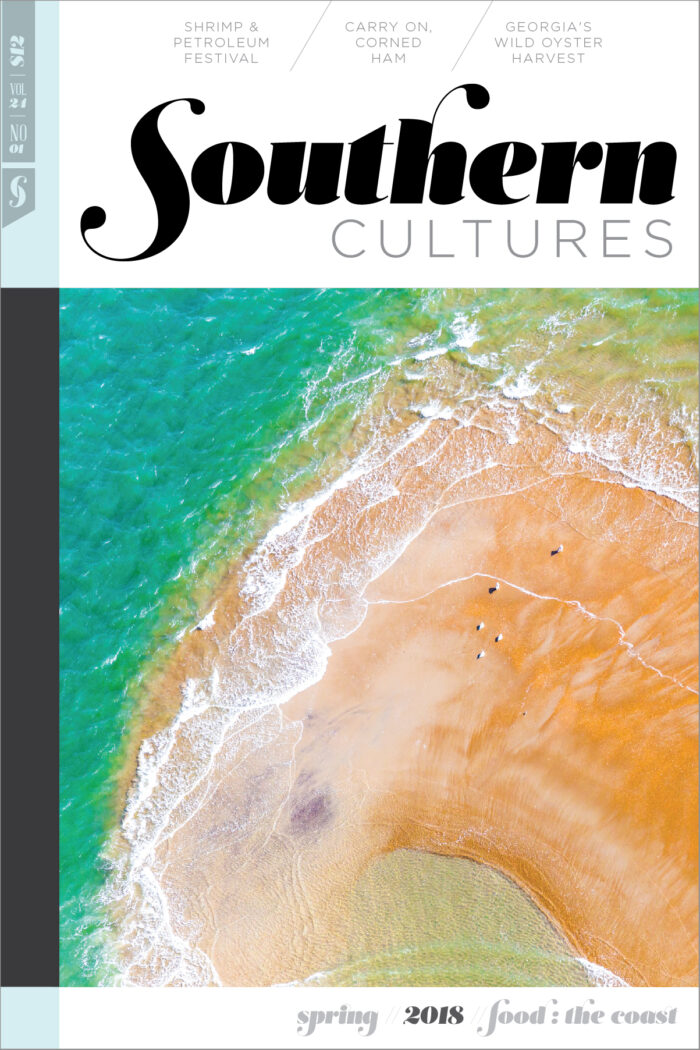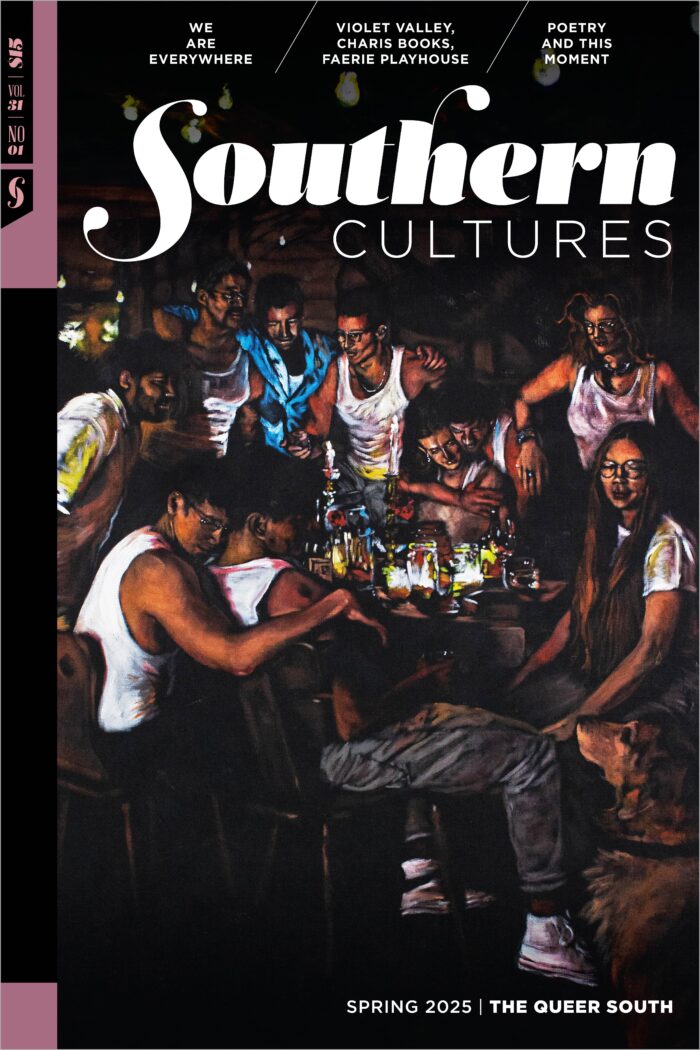Traveling down to the Gulf in Louisiana is like watching intricate sand patterns dissolve in the tide, land slowly giving way to water. Water is everywhere: along the side of the road, under the overpass, hanging in the sky.
Three of us were together in a car hurtling by this watery landscape. Emily Roehl, an artist and oil scholar, had long wanted to visit one of Louisiana’s premiere oil events for a research project. Julie Conquest, an artist and photographer, was game to shoot photographs. And Jeannette Vaught came on the project to gather audio interviews and oral histories with support from nonprofit organizations Foodways Texas and the Southern Foodways Alliance. We all drove from Austin to Morgan City over Labor Day Weekend 2017 in the wake of Hurricane Harvey, which had devastated southeastern Texas just days before, to document the 82nd Annual Louisiana Shrimp and Petroleum Festival. The forecast for coastal Louisiana was iffy, and we anxiously checked the festival website for news of cancellation. We’d joined the panicking people at gas stations in Austin the night before we left, and we’d lengthened our drive considerably by going north from Austin to Shreveport and then dropping down to St. Mary Parish—a good ten hours. Interstate 49 from Shreveport to Lafayette floated uncertainly above floodwaters and looked more like a causeway than a broad, 245-mile interstate highway. We arrived at our hotel in Patterson in the hazy late afternoon, and piled back into the car for the drive to Morgan City shortly after. The festival was on, and we were giddy enough from making the trip after all that worry and all that water to propel us into Friday night.
The Louisiana Shrimp and Petroleum Festival was founded in Morgan City in 1936. It was originally called the Shrimp Festival, a name it maintained until 1967, when “Petroleum” was added. The name change was “overdue,” according to then-president Robert M. Williams: “For the past decade or more, men and women of the oil, gas and boat industries have worked shoulder to shoulder with shrimp and fishing industries and other townspeople in staging the Festival.” Since 1952, the festival has been celebrated over Labor Day weekend and is just one of hundreds of harvest and commodity festivals that take place across the state of Louisiana during the year. A study completed by the Hospitality Research Center at the University of New Orleans estimated that, in 2014, over 140,000 people attended the five-day event, with an overall economic impact of $8.5 million.1
The 2017 festival got off to a soggy start; the music stage and Culinary Classic food vendors had to be moved out of Lawrence Park and onto the street because the festival organizers wanted to protect the grass. The traveling carnival rides, games, and food stalls that set up under the overpass remained dry, although in previous years the carnival area has flooded. As Hurricane Harvey pushed out and the sun came out just in time to set on Friday evening, the festival’s prospects were looking up.
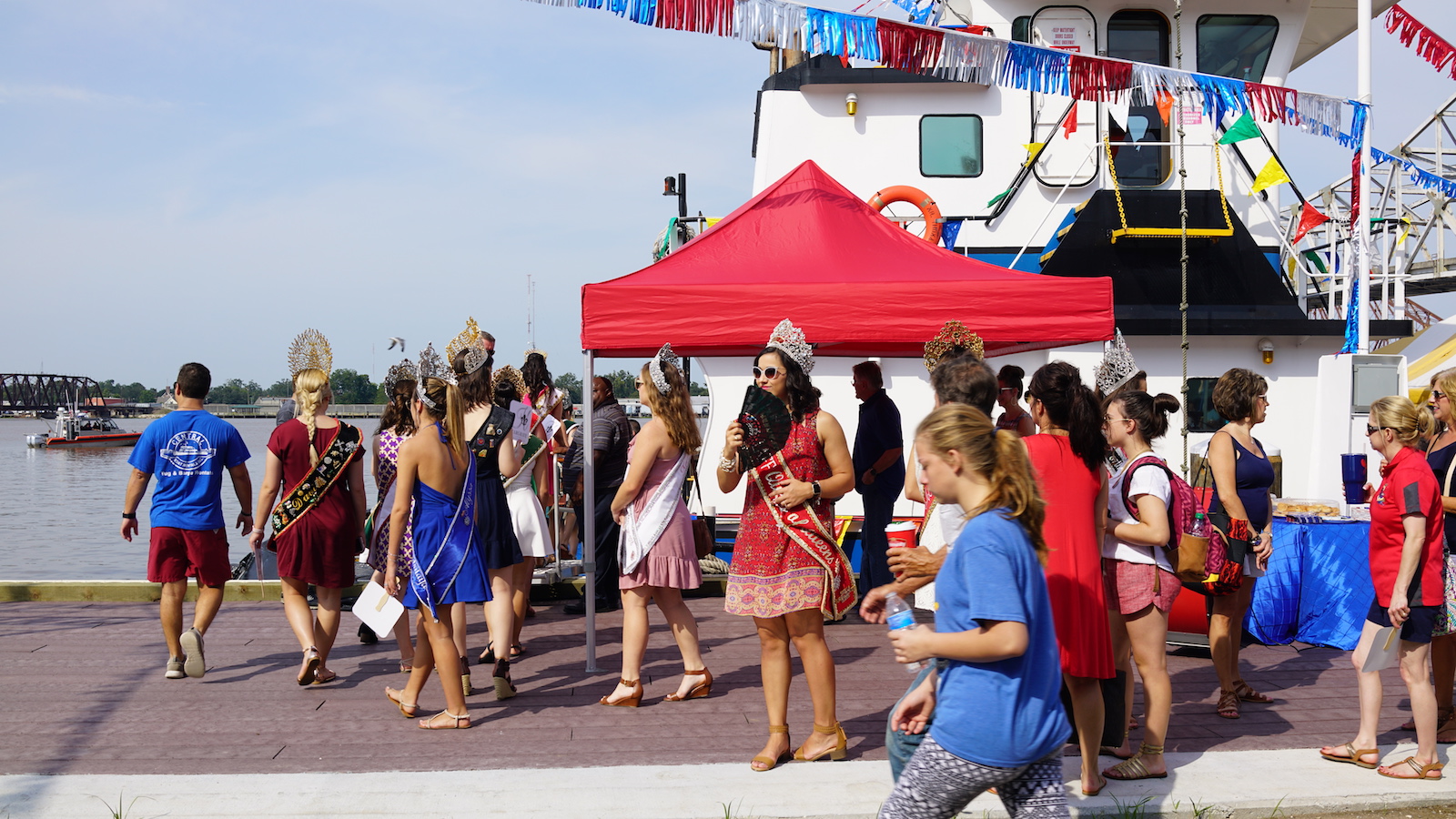
What we found at the 2017 Louisiana Shrimp and Petroleum Festival was a tale of two festivals, not divided, as we had expected, along the odd juncture of shrimp and petroleum—but, rather, between the official festival, with its pageant queens and time-honored ceremonies, and the festival as it was enjoyed by the people of Morgan City and St. Mary Parish, which was a much more racially diverse and less scripted experience. We were there to conduct oral histories and take photographs, ostensibly to observe, but the overwhelming whiteness of the official festival made us all the more aware of our own whiteness and the near-absence of people of color in the festival’s official events. The same was true of class; while both the shrimping and petroleum industries in southern Louisiana employ large numbers of working class laborers, and although the festival began in 1936 as a labor demonstration of shrimpers and trappers, the current festival producers downplay its working class roots.
What we found at the 2017 Louisiana Shrimp and Petroleum Festival was a tale of two festivals, not divided, as we had expected, along the odd juncture of shrimp and petroleum.
When we arrived at the festival that muggy night in early September, we wondered what the weekend might hold. The full picture wouldn’t develop until the last night of our visit as we swayed at the top of the candy-colored Ferris wheel. By then, we had come to see the convergence of the two festivals—the formal and the public—as a powerful convergence of the city’s divided past and its hopeful present.
As we drove into Morgan City, the twinkling lights of the Ferris wheel rose up directly next to the overpass, sherbet-hued gondolas tilting in the pale sunset light within spitting distance of the hulking highway. The intersection of concrete and whimsy was unexpected and delightful. The view from the highway, so blurry, plain, and predictable, could not have been more different from the view from the top of a Ferris wheel—stillness, slow motion, and repetition. For a moment, we felt as if we were already on the Ferris wheel, the toll of miles logged that day instantly replaced by the thought of going in slow circles, of taking time with a particular view, of feeling the rush of going vertical.
A Gateless Festival
The Shrimp and Petroleum Festival does not have a ticketed gate entrance, so folks pull up on the median of a boulevard on the east side of downtown and walk on over. It is a true public festival: people living in the houses by the park are out on their porches, drinking, hosting friends and family, waving at neighbors. Neighborhood locals dip in and out. And for many, the festival is a good reason for families to come together. Young people raised in Morgan City are increasingly making their lives elsewhere, but they come back over Labor Day weekend to enjoy the festivities. Two St. Mary Parish natives with very different family histories shared their experiences of having grandchildren who left the area. Fulton C. “Butch” Felterman, a prosperous former shrimper and King of the Shrimp Festival in 1957, lamented, “Our four surviving children, all of them live here. But it looks like that’s going to be the end of that. The next generation is the one that said, ‘No, we’re not going to live in Patterson.’ They all moved away! They live in other parts of the country.” We met his far-flung adult grandchildren, who’d come home for the festival from Chicago.
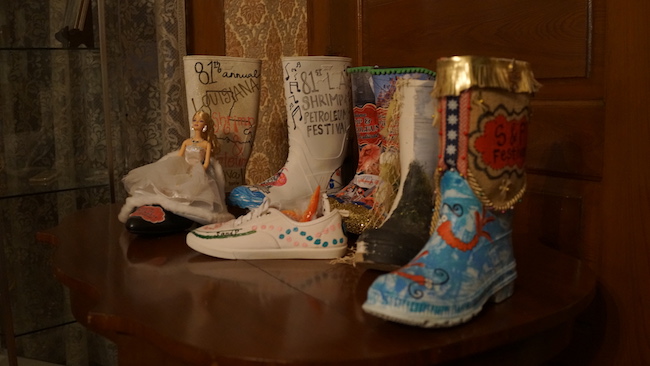
Lonnie and Jada Gray, whose ancestors weren’t permitted to be shrimpers because they weren’t white and who hunted alligators in southern Louisiana swamps instead, described the same pattern: “[A]ll our kids are basically grown and gone and work out of state. . . but they always come home for the festival.” The Grays’ children and grandchildren couldn’t make it down this year because of the flooding in northern Louisiana, however, and they felt the loss.
As the lights of the carnival intensified in the failing dusk, we walked up the steps of the festival headquarters. Members of the board were hanging a large welcome banner from a second-story balcony. Our first encounter was with Neal Mayon, a festival organizer who, we later learned, was also entrusted with its archives. He gave us a generous welcome and showed us in.
Inside headquarters, we found a nicely appointed entry hall leading to a winding staircase. Between two doors that led to formal reception and dining rooms, there was a table stacked high with elaborate scrapbooks from previous years’ festivals. Next to the staircase, the 2017 poster was displayed on an easel. Each year, the festival commissions a new poster. This year’s design features an American flag background with a shrimp motif that gives it a soft, quilted appearance; above this, there is a landscape scene in the shape of Louisiana, where a blue oil derrick rises from the water in a cypress swamp. Behind the derrick is a setting sun with the same pink and gold clouds we saw while driving across the bridge into town.
The reception and dining rooms held treasures of festivals past: a scrapbook the size of a side table decorated with plastic shrimp and boats made to commemorate the eightieth year in 2015; rubber boots decorated with googly-eyed shrimp and stick-figure oil derricks for the eighty-first festival in 2016; a glass case with rhinestone crowns and other regalia; a copy of A History of the Louisiana Shrimp and Petroleum Festival, by Cindy Landers Thibodaux, published in honor of the festival’s fiftieth anniversary in 1985; and a poster from 1982 with an offshore rig, refinery, and shrimping boat in the background, barrels of oil and a clutch of shrimp in the foreground. Just inside the door to the formal reception room sat a floral arrangement like none we had ever seen: an iridescent pink shrimp twisted around a three-foot-tall sparkling oil derrick among a spray of plastic flowers and cattails.
Mayon graciously offered to let us record audio on the second floor of the headquarters, and we followed him up the winding staircase. He explained that the headquarters had previously housed a Mardi Gras museum. At the landing, we found ourselves amid the detritus of a shipwrecked museum, boxes of paper décor and mannequins in extravagant costumes like rescued cargo packed haphazardly into a set of rooms. For the next two days of recording, we would set up shop in the shadow of a boldly festooned Mardi Gras mannequin with a blue and white mantle.
Mayon gave us space for interviews and introductions, a real welcome. He helped us set up a table and chairs and figure out how to work the air conditioner so it wouldn’t mar the audio for our longer recordings. But he did not give us an interview. He did introduce us that first night to Nathalie Weber, who had been queen of the festival in 1968 and is now the president of its board. She helped connect us with several of the visiting queens the next day, but she firmly rebuffed all of our requests to sit down and talk with us as well. Microphones are intrusions, as we were to the festival, to the house, to her and Neal’s work keeping the festival running that weekend. Not getting interviews with the festival’s archivist and a woman whose experience with it has spanned nearly a lifetime was a real disappointment—one that highlights the kind of insider/outsider boundaries that aren’t readily apparent at a gateless festival.
The upstairs window at the headquarters looked directly out on the carnival under the highway, the lights turning the drab underside of the overpass into a bright blinking backdrop. As Mayon explained, the house we were standing in used to be where the overpass is now. It and other historic Morgan City houses had been moved to make way for the highway—the “new bridge”—in the 1970s. The houses had been built with shrimp money a century ago; the highway had been built for oil, logistics, supply chains. Now the house overlooked both of its histories together in the flickering shadows of the carnival lights.
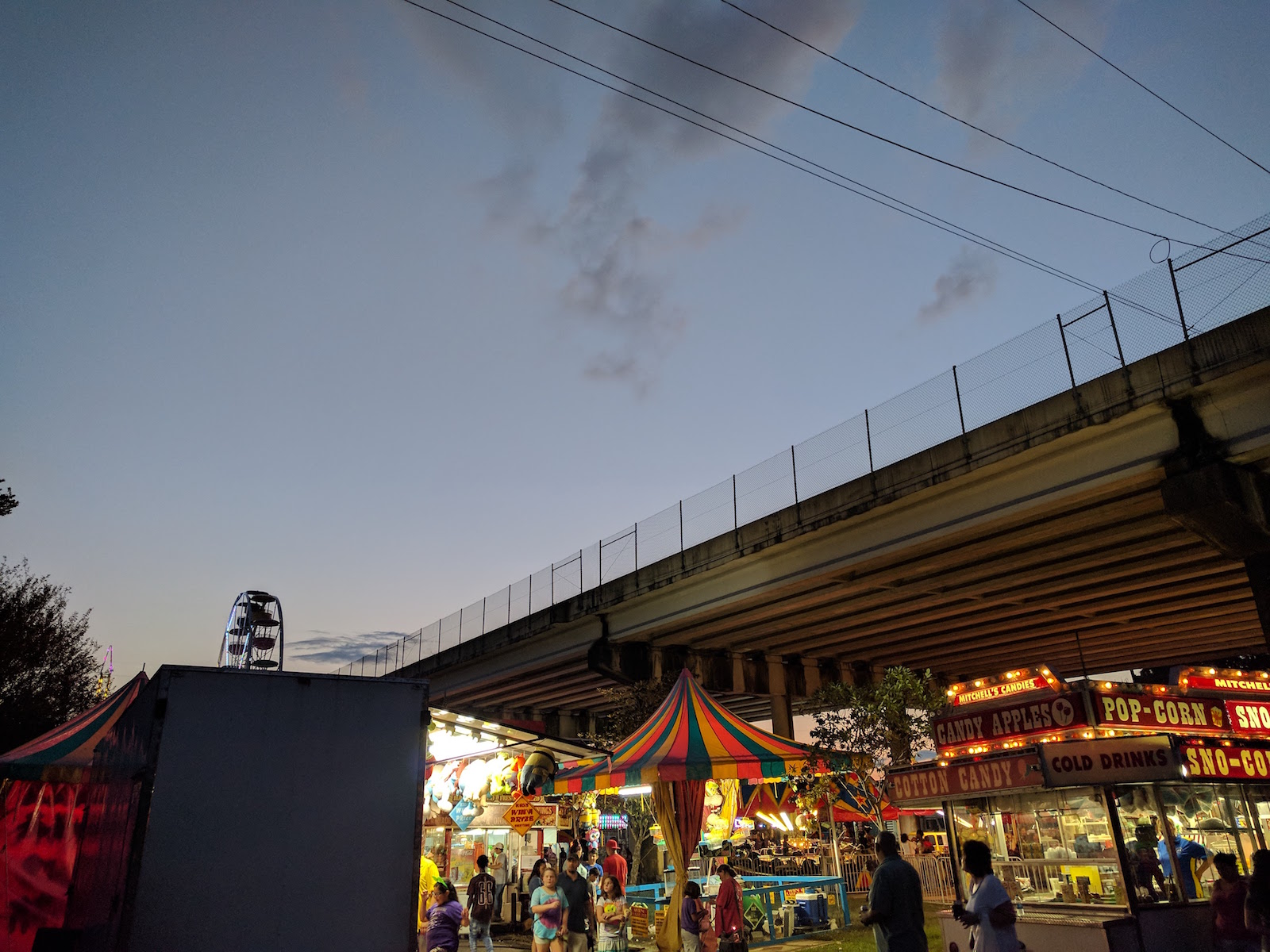
From Shrimp to Oil
Industry in southern Louisiana shifted from shrimping to capturing, refining, and shipping oil in the 1960s, and in 1967, the oldest chartered harvest festival in the state of Louisiana changed its name from “Shrimp” to “Shrimp and Petroleum.” The continued inclusion of “shrimp” in the festival’s title is an annual reminder of how people used to make their living here and how the town remembers that legacy. At about the same time that labor movements gave way to right-to-work laws in the Sun Belt South, the formal events of the festival became primarily organized around the idea of symbolically “marrying” a young shrimp queen to an industry-elder oil king, uniting the two industries in a ceremonial display of age, beauty, and industry in perpetuity, most clearly expressed through the Blessing of the Fleet.
The continued inclusion of “shrimp” in the festival’s title is an annual reminder of how people used to make their living here and how the town remembers that legacy.
The immediate strangeness of the pairing of shrimp and petroleum in the festival name may obfuscate the far stranger symbolic marriage ritual uniting an underage student and a man often old enough to be her grandfather. While there have been kings and queens at this festival since 1943, initially, the king was a shrimper whose boats brought in the biggest catch. And boats are still at the center of this strange marriage ritual, where typically a King’s boat and a Queen’s boat will physically touch, or “kiss,” as the crowning moment of the Blessing of the Fleet. We spoke at length to “Butch” Felterman, a kind and sharp nonagenarian who began shrimping in St. Mary Parish as a young man right after the end of World War II. He gave us a very clear idea of how boats became a powerful tool of upward mobility when the oil industry moved into the estuarial coast. By 1949, he’d become a very young but successful shrimp boat captain, and owned his own boat. “In 1957,” he told us, “I was what they call ‘high boat,’ which meant that I brought in more shrimp to this area, the Morgan City/Patterson area, than any other skipper, so that festival named me king for 1958.”
Oil companies had begun offshore exploration by then, which drastically reduced work opportunities for Louisiana shrimpers. Felterman explained,
If [the seismograph crews] came to a site that for some reason looked more productive they’d sometimes take four of those cans, 200 pounds of Nitromon, make a huge, huge splash in the water, shooting water up in the sky. The fishermen didn’t like that. We claimed that they were blowing holes in the bottom and causing problems with our trawls, and digging in and tearing up the nets.
In the early 1960s, Felterman had just built a seventy-two-foot steel-hulled shrimping boat when he was approached by a seismograph crew.
I built a cabin on it, put the engine in it, all the rigging, and it was a fine boat, seventy-two feet in length. And the seismograph guy came to me, he said, “Man, we could sure use that boat. Would you be willing to lease it to us?” And I’d just been cussin’ these people [laughing]. And now here he wants to pay me good money to rent the boat, hire a crew, and that was kind of hard to pass up. Truly, that’s how I got started in the oil boat business. We had both types of boats, shrimp boats and oil field boats, for a while. But by about 1970 we had sold the last of the shrimp boats and worked strictly in the oil boat business.
Felterman made the rest of his long and successful career building boats for the oil industry in southern Louisiana. We asked him if it was common for shrimpers to make the transition into the oil industry after the shrimp had been blasted away. He said no; most of the shrimpers simply left.
When the shrimp played out offshore from here, most of the people moved down to the Brownsville area . . . so they were able to fish both Texas and Mexican waters. Now, a few boats early on would run from here—let’s say from Morgan City—run straight across the Gulf and fish in the Bay of Campeche. It would take around seventy hours to run down there to fish in the Bay of Campeche and bring the shrimp back here. But that didn’t last very long . . . They moved to Brownsville, or there were some of them that fished out of Mexican ports for a while. That didn’t last either [laughs]. Too much payoff down there.
Felterman, being a boat owner, was able to make the transition from shrimp to oil easily and profitably. But for those whose work was harvesting shrimp, that transition was more difficult. By the mid 1960s, as the shrimping industry fully yielded to oil, the festival added “petroleum” to its title and a Petroleum King to its court. Rather than being chosen by virtue of measurable production, Petroleum Kings were, and are, chosen by a group of peers, often managers and executives in the oil and oil-boating industries.
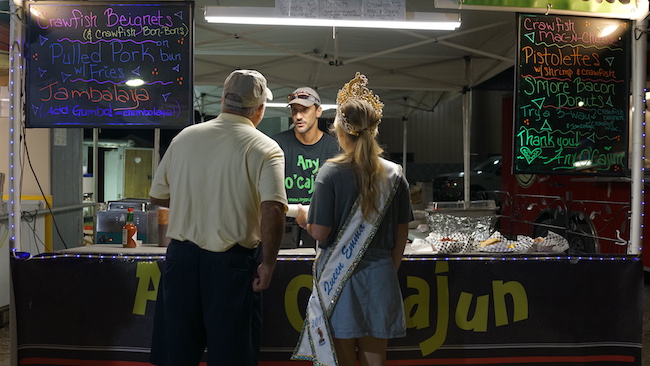
Becoming the festival’s queen is a far more arduous and regimented process, one that clings to Gone With the Wind–era conventions of white southern femininity. The call for applications to become the 2017 Shrimp and Petroleum Queen couches these expectations in vague but coded terms. The would-be queen “must not conduct herself in any manner other than that befitting of a queen,” the rules proclaim, then further implying that only virgins need apply. The Shrimp and Petroleum Queen must be “between the age of 18 and 23,” and “shall never have been married, pregnant, or given birth to a child.” These “maidenhood” rules are enforced by the Louisiana Association of Fairs and Festivals (LAFF), which oversees all of Louisiana’s harvest and commodity festival pageants. Each year, LAFF chooses a queen from over sixty local fair and festival queens to be the “Queen of Queens,” which, for many contestants, is the culmination of years of competing for titles at festivals just like Shrimp and Petroleum. While the Shrimp and Petroleum Festival is among the oldest and most storied of the Louisiana festivals, it does not rank higher than others; it is just one of the more than sixty fairs in the LAFF system.
We spoke to the 2017 LAFF Queen of Queens Julian Devillier, who has been competing in pageants since she was three years old, when she was crowned the Louisiana Baby Cattle Queen. Since she was a child, the Queen of Queens “has always been my role model . . . and the greatest honor somebody could have.” Devillier explained how girls compete in various age categories: “as age category changes, you can go from Little to Deb to Junior. It varies between pageants, but there’s a category for each age, and Miss is the one that’s really serious and involved, [the] one . . . all the queens that you see here this weekend [are competing in,] including myself.” Devillier, like many of the queens we spoke to over the weekend, demonstrates years of pageant experience in well-rehearsed responses that expertly turn to the community and commodity she represents. They are troves of agricultural market information—statistical, historical, economic. Under glittering crowns and through bright-lipped smiles, they turn our questions into opportunities to educate us with up-to-the-minute commodity data, and to express profound compassion and respect for each other’s knowledge. A number of these young women are putting these years of preparation to use in college by majoring in media and communication studies. Many have been friends on the Louisiana festival circuit for years, finally reaching the “serious and involved” level of Miss competitions, eyeing that ultimate goal of being Queen of Queens.
Devillier made her way into the Queen of Queens competition by being crowned the queen of the 2017 Louisiana Fur and Wildlife Festival. The title was so important to her that she put off a milestone event that would have disqualified her from the competition. “Well,” she explained to us, “three weeks ago I was supposed to be married. I got engaged a few weeks before I won the Fur title that I represented for a year last year.” She had to delay the wedding to be eligible for the LAFF competition. “But I am going to get married in April, so that’s my next title that I want to take over,” she laughed. Without a visibly booming shrimping industry in Morgan City to back up the shrimp side of this economic and cultural equation, this once-profitable little crustacean came to reflect a host of projections. Rather than denoting the decay and stagnancy of a dying industry, the shrimp became a symbol of youth and (re)productive potential.
In Morgan City, of those with generational ties to the pre-1960s shrimping industry, only those who were able to profitably parlay their shrimping business into provisioning the early oil rigs any longer live there. What was new in the 1960s is tradition now. The historic shrimp of Morgan City’s past can ride the coattails of oil’s relative success, but what remains of it is a bevy of bright young women competing for a crown. This festival is about commodities and supply chains all the way down, even—and perhaps especially—in the pageant.
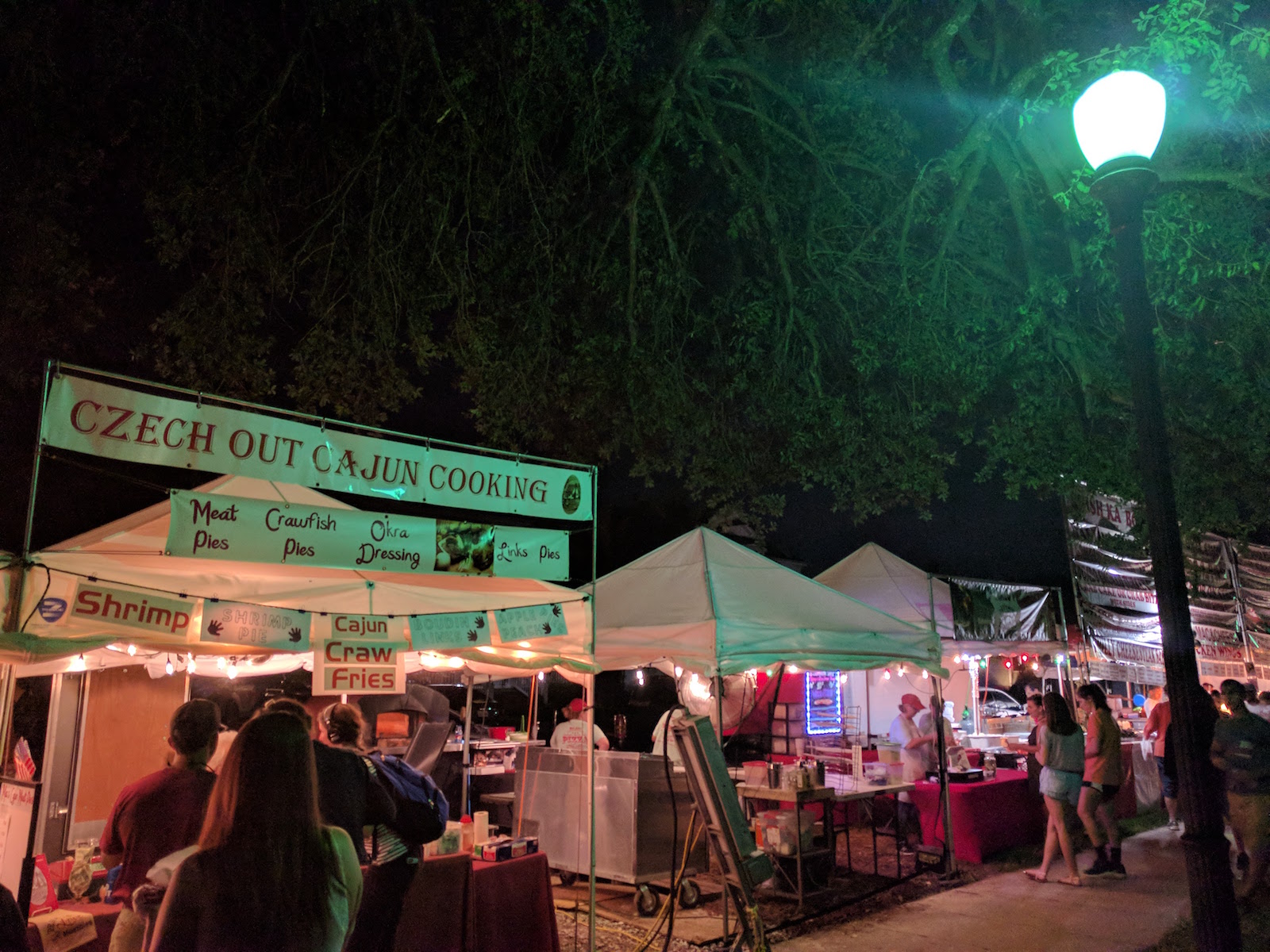
Commodity Queens
On the Saturday of the festival the queens participate in several activities designed to engage them with either shrimp or oil. In 2017, accompanied by several past queens, they visited Mr. Charlie, a decommissioned oil rig that anchors the International Petroleum Museum and Exposition in Morgan City. The queens were also presented to festivalgoers on the music stage, where each one introduced herself and her local festival commodity. Later in the afternoon, they made string art crafts related to the festival. Most of the queens chose to form crowns out of string; only one chose to make a shrimp. In fact, very few of these Louisiana queens are familiar with the shrimp industry at all. In 2017, for the first time, one of the queens’ events was a trip to Patterson Light, a recently renovated building that sits on a bank of the Atchafalaya River in the neighboring town of Patterson. Built by Felterman for the express purpose of preserving knowledge of the area’s shrimping history, it contains a small museum of the Patterson–Morgan City shrimping industry.
That Saturday afternoon, nearly twenty young women in rhinestone crowns and satin sashes over their shorts and festival shirts gathered in the museum to watch a video produced by Felterman. The film featured Felterman’s grandson playing the role of young Butch and traced the history of the shrimping industry that years ago hummed along the estuarial river flowing just a few feet away.
The queens generally knew little about the shrimping industry in Morgan City, although perhaps the visiting shrimp queen and crawfish queen from farther east along the Louisiana coast were more familiar than others. The remaining women are representing other parts of Louisiana with different commodity identities. Shrimping isn’t in their families’ backgrounds or their region’s production—and if it were, it was now several generations ago. What are in these women’s backgrounds are pageants. Grandmothers, mothers, sisters, cousins, aunts, sisters-in-law—for some of these women, the female networks they inhabit are awash in pageant queens. The people who worked in shrimping, and who now work in oil, or work somewhere else, don’t dream of becoming pageant queens. When we spoke to Morgan City locals Lonnie and Jada Gray, who have coordinated all the electrical work for the Shrimp and Petroleum Festival for the past eight years, they just laughed when we asked them if they knew anyone who had wanted to be the Shrimp and Petroleum Queen. And they also shook their heads when we asked if they had any ancestral connections to the shrimping or oil industries. We later learned that African American Louisianans weren’t part of the shrimping industry at all. When the shrimping industry was booming, it was militantly segregated. Oral history accounts are harrowing: “[African Americans weren’t] allowed out there [in the 1940s and ’50s]. We wasn’t allowed in the Gulf, period. Doing anything. Shrimping, they’d shoot at us.”2
While the oil industry did integrate later on, African American natives of St. Mary Parish did not necessarily enter into that kind of work. The demographics of current pageants, which seem to skew surprisingly white given the demographics of Louisiana, are in fact representative of the historical divisions that kept black Louisianans out of both industries and their festival cultures. But Lonnie and Jada also take pains to tell us that the festival has been opening up to include more of Morgan City’s black and Vietnamese populations. “You know, the tolerance level of accepting other people’s cultures has grown,” Lonnie emphasized. “So what I think . . . is it grew from a small town fair with very limited opportunities for people to be included from different cultures, because it was predominantly of the oil area, you know, and it was looked upon basically as wealthy people, and their kids . . . But now they’re including all classes of people, all races, all cultures. And now it’s more of a different atmosphere and a more accepting and tolerant atmosphere.” Of course, this history is not covered in the video at Patterson Light.
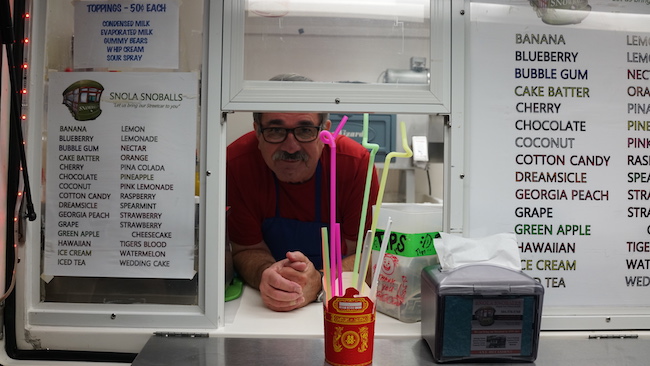
Not A Food Festival
The Louisiana Shrimp and Petroleum Festival is not a “food festival” in the way those events are often construed today, full of TV chefs and pop-up restaurants and brands and small bites and flavor innovations and foodie swag. Perhaps this is why, when we talked to nearly any non-Louisianan about going to the festival, they responded with some form of ew, an expression of mild disgust at the cognitive dissonance between a food product and the oil industry. People’s immediate reaction was that petroleum, that big downer, had no business at a food festival. Mix in the widely held cultural notion that Louisiana food is delicious and add in a dash of “those people” judgment holding that deep southerners broadly and Louisianans specifically might have laxer standards for food purity. Or, even worse, that they had forgotten the proper southern food–adjacent oil was butter or lard. Petroleum is, simply, the wrong kind of oil. It’s the kind of oil we don’t like to think about. It’s the kind of oil that is completely embedded into our food and its packaging and its distribution systems but that makes it the kind of oil we don’t like to be reminded of.
And while there is an abundance of food at the festival, it is primarily an industry festival. The queens represent industries, food as commodities. So while the food is a huge draw for both the formal, royalty-oriented festival events and the informal, diversely attended festival events, it is not, contrary to what we expected, the point—a fact that makes the junction between shrimp and petroleum less dissonant. The petroleum piece of the Shrimp and Petroleum Festival is, of course, its raison d’être; it is the festival’s financial underwriting and the town’s main industry. Its centrality is evident in the event’s logo, which features a bright pink shrimp in a yellow hard hat wrapped around an oil derrick, as in the flower arrangement we encountered in the Festival Headquarters. This logo is visible on the giant banners that flank the music stage and on posters and signs on the festival grounds. Necklaces with shrimp beads and oil derrick beads were a prized catch at the parade, where you could also snag candy and plastic cups as they were thrown from the passing floats.
The embrace between shrimp and oil in the festival logo is appropriate, even if many would prefer not to consider the intimacy of food and energy. Oil goes all the way down our food system: it’s in the tanks of the vehicles that deliver our food from where it was grown or raised to where we eat it, of course, but it’s also in the vehicles that prepare the soil and harvest the food, it’s in the plastic components of those vehicles, it’s in fertilizers and pesticides, it’s in industrial machinery, it’s in packaging, and its residues are present in human bodies. Oil makes the global food industry possible. It’s also highly polluting. The Shrimp and Petroleum Festival isn’t interested in making this point, but it wasn’t lost on us as we sampled foods from the Culinary Classic and carnival booths, where the oil on most people’s plastic plates was canola.
If we are honest about how food grows and gets to every plate, every “food and wine” festival could rightly be a “food, wine, and petroleum” festival.
If we are honest about how food grows and gets to every plate, every “food and wine” festival could rightly be a “food, wine, and petroleum” festival. But the Shrimp and Petroleum Festival isn’t primarily a food festival. Each and every queen who represents her festival on the circuit can rattle off a long list of statistics and factoids about the economic impact of her town’s agriculture. And while food festivals increasingly include information about where their ingredients come from, few would be caught honoring “Big Ag” corporations, technologized growing practices, and large-scale commodification.
From Shrimp On a Cupcake to Meat On a Stick
The Shrimp and Petroleum Festival may not be a traditional food festival, but there is a vast array of food to purchase once you’re there. The food areas of the festival occupy three separate zones: one includes the neighborhood establishments of Morgan City itself; a second is the Carnival Zone under the highway overpass, where mobile food businesses contract with the city to rent space and sell their food items for profit during—but otherwise unconnected to—the festival; and the third is called the Culinary Classic, which is supported by the festival and takes the form of an avenue of temporary kitchens set up inside the festival area. Each kitchen is staffed by volunteers for local charities, which apply for a spot to prepare and sell food to benefit their causes. The Culinary Classic stretches an entire city block, a veritable tent city run by a volunteer army, cooking away as the heat of the afternoon gives way to the humid sheen of the evening. It reveals the shrimp-laden, oil-frying beating heart of local St. Mary Parishioners.
These three zones offer a master class on establishing and breaking down stereotypes of coastal Louisiana food. Our first night in town, we stuffed ourselves at Rita Mae’s, a black-owned restaurant whose menu reflected a classic array of hearty, spicy rice-based stews. Shrimp, crawfish, and catfish were the mainstay proteins. Po’ boys, gumbo, jambalaya, and étouffée were the flavor vehicles, and okra made an expected and delicious appearance. This was food that fit comfortably within our understandings of “coastal Louisiana cuisine” or “traditional Louisiana food.”
Walking the stretch of the festival’s Culinary Classic is an education in community-building in Morgan City and why making and selling food is integral to the missions of local charitable organizations. From the Lions to the American Legion to private donors, churches, and school groups, each tent had its own way of blending its community mission with a particular food identity. This stretch also highlighted Lonnie Gray’s assertion that the festival has made room for multiple Louisiana cultures. The multiracial, multiethnic volunteer staffs were a stark contrast to the royalty events. One tent, decorated in Mardi Gras colors, served Creole food staples, much like Rita Mae’s. Their jambalaya was transporting. A few tents riffed on the shrimp theme, including tasty fried bacon–wrapped shrimp nuggets from the Lions and a mean shrimp pie at a stall promising Czech Cajun cuisine. The proprietors told us about how their Cajun ancestors married Czechs who got Cajun-ified within two generations. One stall dominated the dessert game with New Orleans–style snoballs, the absurdly sweet concoction made with condensed milk. Perhaps the most surprising crowd favorite, however, and the one that we couldn’t leave the festival without trying, were the burgers from the local Catholic high school stand. Many folks told us it was their favorite festival food. A burger? At the Shrimp and Petroleum Festival? Smothered in caramelized onions and nacho cheese, it was exceptional.
Despite this cultural and flavor diversity, the tent run by a local Vietnamese Catholic church was the only sign we saw of the Vietnamese American population that shrimps widely along the Louisiana and Texas coasts. The Louisiana Shrimp Association estimates that nearly a quarter of the commercial shrimpers along its coast are Vietnamese religious refugees—who were brought to live in Louisiana by Catholic charities in the state—and their descendants. Like animist Hmong refugees who aided U.S. military efforts and resettled in the United States following the Fall of Saigon in 1975, many Catholic Vietnamese war refugees were persecuted in Vietnam for their religious practices and political alignments. Unlike resettled Hmong communities in urban California and Minnesota, however, the Catholic Vietnamese in Louisiana were familiar with the local industry. Having been commercial shrimpers in Vietnam, they quickly started their own shrimping businesses. Their story is often left out of dominant narratives of the “end” of southern Louisiana shrimping.3
Despite the transition into familiar work, Catholic Vietnamese in Louisiana, like the Hmong, did not seek to assimilate fully into American culture. Vietnamese shrimpers built thriving communities and businesses within a Gulf economy that favored cash and a quality product. In Morgan City, the transition from shrimping to oil among the city’s American population made Vietnamese shrimping communities even less visible—which was reflected in their near-total absence from the festival and stories about shrimp. There was no Vietnamese presence among casual festivalgoers, at any of the formal events, or even among those enjoying the carnival. In this food tent, however, a bevy of extended family members was cooking away. After taking an interview with them, we sampled the food they told us was the best they served—roasted, seasoned pork on a long stick. It was delicious, and unique among the many food options along the Culinary Classic block. It was not fried to a golden crisp; it did not have a Cajun spice profile; it did not contain shrimp. But it was nonetheless the most quintessential fair food possible: meat on a stick. It was 100 percent fair food and 100 percent unassimilated at the same time.
Meats on sticks were the primary food genre in the Carnival Zone, which was run by Mitchell Bros. and Sons Amusements, a company that operates in Louisiana and Mississippi but features many of the foods and attractions that have become part of a national carnival culture. While we chose a different food vehicle for our last dinner at the festival—bread, in the form of a “Bayou Boat,” a crisp-fried bread bowl full of spicy, creamy crab stew (it was like eating out of a beignet)—the Carnival Zone offered hundreds of meat/stick combinations. Carnivals like this one travel, so its vendors were not necessarily representatives of the local food scene. But they did trade liberally in stereotypes of coastal Louisiana cuisine. The effect was a stunning cognitive dissonance between two senses of place, “Louisiana” and “fair.” Regionally situated ingredients like “gator” were wrapped in the familiar packaging of fried or on-stick fair food that one expects in any county or state fair across the nation. The fair did have a booth where we could sample a beverage claimed by the Festival as its own: Petro Punch. Just like its sugary and neon-tasting cousin, the Bourbon Street Hand Grenade, the rummy drink got surprisingly tastier with each sip. This travelling carnival, temporarily attached to the Shrimp and Petroleum Festival, managed to be both perfectly integrated with its specific food aesthetic and also completely portable and generic.
Two Scenes on the Sea Wall
On the western edge of town, up against the Atchafalaya River, sits the seawall, site of one of the most dramatic performances of the Labor Day Weekend. Since the 1930s, during the annual Blessing of the Fleet, a priest has blessed each boat as it passes by, throwing holy water from the edge of the Morgan City docks. In previous years, the king and queen of the festival had their own boats, which would meet in the river for a “kiss” and champagne toast across the bows. This year, due to insurance and fuel expenses and the scarcity of boats amidst Harvey recovery, the king and queen shared the Margaret Lab, a large cargo ship used to take supplies and workers to offshore oilrigs. As we walked from our car across the hot asphalt to the Morgan City seawall, we noted the irony that fuel prices were a limiting factor at a petroleum festival held in the shadow of a decommissioned oil rig.
As we arrived at the docks, we passed below a glittering silver banner that read “82nd Blessing of the Fleet.” American flags anchored the corners of the banner and red, white, and blue streamers lined the docks, reaching up to the seawall. A woman sang “God Bless America” over the pa system, the notes mingling with the sound of idling boat motors, the drone of industrial fans, and the chatter of the crowd. The visiting queens posed on the bow of the Mr. Thomas for the iconic Titanic shot. Red and white shade tents protected plastic food trays full of deviled eggs topped with tiny shrimp, finger sandwiches, and delicate cookies, which were served on laminated American flag paper plates. Folks fanned themselves in the meager shade of the seawall. Festivalgoers mopped their faces in the still, heavy afternoon air. The water parade spanned the stretch of the Atchafalaya River between the old bridge and the new, and the whole scene was observed by Mr. Charlie, the decommissioned deepwater oil rig. When the toast was made, the “marriage” between shrimp and petroleum was official.
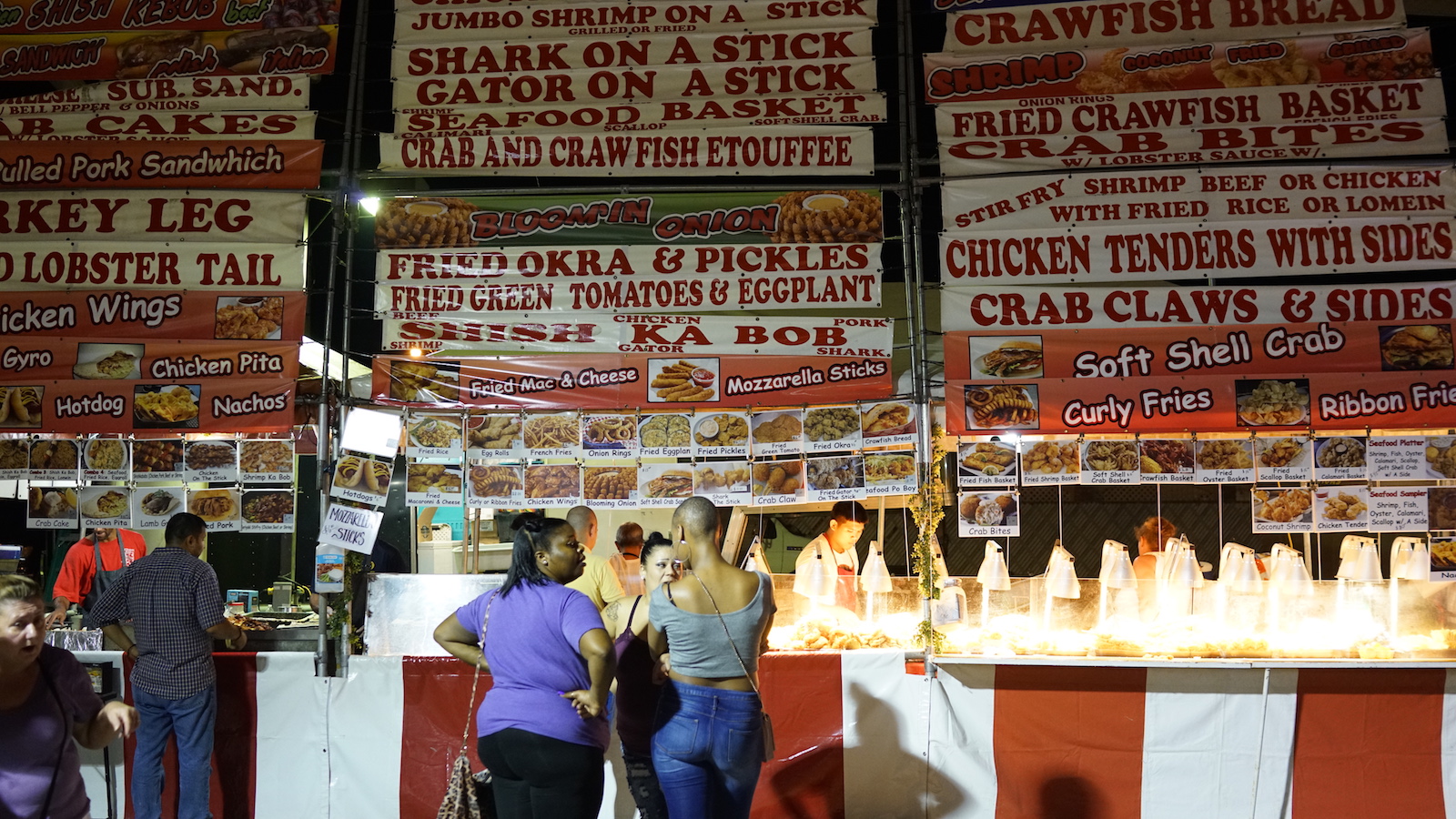
Each year, the entire town shows up for the consummation of this “marriage,” which takes place over the Atchafalaya River after sunset. Timed to a series of rousing songs on the local radio station, the festival comes to an impressive climax with a large and lengthy fireworks display.
Near the end of the display, there was a collective gasp as what seemed to be every remaining firework was launched in one massive volley. As the sky exploded, hundreds of people standing on the seawall exclaimed in unison. We had seen a lot of glitter over the weekend: glittery shrimp, glittery derricks, glittery signs, rhinestone crowns, rhinestone pins, rhinestones and glitter on the covers of scrap-books, shiny beads thrown from parade floats, iridescent shrimp wrapped around floral arrangements, but what we saw on the seawall on Sunday night was something altogether different. The fiery spray sent a quiver down the seawall, and for a few seconds we were, all of us, part of it.
From the Ferris Wheel to the Overpass
Our festival ended where it began. We used the last of our cash to purchase a packet of Ferris wheel ride tickets from the small booth at the entrance to the carnival. The fireworks show had come to a close, and the craft fair vendors were packing up their yard art, hair bows, airbrushed t-shirts, magnets, and alligator heads. As we reached the peak of the wheel’s circuit, we could see the whole city stretched before us, from the seawall to the highway, people lining the streets, dancing at the concert in the park, the festival buzzing below as it spread beyond its formal boundaries. The highway stretched to the west, back toward Texas, hundreds of miles of road between us and home. The Ferris wheel circled lazily, lifting us up above the muggy crush of people in the carnival grounds below, and a bigger picture started to emerge.
Through the lingering firework smoke, we could see kids running through the carnival grounds below and cars crossing the bridge beside us. We basked in the smell of food stalls and the glare of oncoming traffic. We took big gulps of cool air and tasted spent gunpowder and exhaust. We had come to Morgan City to eat a lot of shrimp; we had done that. As we shuddered at the top of the Ferris wheel, we realized that we’d consumed a lot of oil, too. Our whole weekend was hemmed in by petroleum, from the gas we used on our nail-biting trip across Harvey-ravaged Texas and Louisiana, to the oil derricks on plastic necklaces and rhinestone pins and flower arrangements, to the steady stream of comments from festivalgoers about the weather. “Will it rain?” Weather, too, is oil all the way down, as fossil fuel–induced climate change causes more severe storms, and more of them. Our ride on the Ferris wheel was a nice diversion for us and for the people of St. Mary Parish from the difficult realities of hurricane season in the Gulf South: the ever-present threat of wind and water. It was also a diversion from the difficult realities of a gateless festival devoted to an industrial history with strict race and class boundaries that remain visible in the official festival events. As its dissonant name suggests, the Shrimp and Petroleum Festival resists easy interpretations. Being outsiders, we were aware of some of these frictions, but we were ourselves beguiled by the rhinestones in our eyes, by the fireworks display, and by the warm, generous welcomes we received from the community.
This essay appeared in Food IV: The Coast (vol. 24, no. 1: Spring 2017).
Emily Roehl is a PhD candidate in American Studies at the University of Texas at Austin and the co-founder of Mystery Spot Books, an artist book publisher based in Minneapolis. As a writer and photographer, Roehl focuses on energy, environmental justice, and visual culture. In her dissertation, she looks at landscape photographs of extractive sites from upstream to down in the material life of oil, from the tar sands of Alberta to the proposed routes of the Keystone XL and Dakota Access pipelines. Roehl is interested in the aesthetic strategies of artists and activists who address the unevenly distributed risks of energy development.
Jeannette Vaught holds a doctorate in American Studies from the University of Texas and teaches interdisciplinary writing and science studies at California State University, Los Angeles. She was formerly an equine veterinary technician, and her work is focused on the infrastructures aligning animals, food, reproduction, and science. She is at work on a manuscript about the historical biopolitics of reproductive technologies used to create agricultural animals, and is also working on Locust for Reaktion Books’ Animal Series.NOTES
The authors would like to extend deep thanks to the Southern Foodways Alliance for funding travel and providing equipment for this project, and also to Foodways Texas and the Department of American Studies at the University of Texas at Austin.
- The Louisiana Shrimp & Petroleum Festival Facebook page, post from November 6, 2017, https://www.facebook.com/shrimpandpetroleumfestival/. The Hospitality Research Center’s study was featured in a KATC news story touting the positive impact of the festival and the oil industry on St. Mary Parish; see “Study Says La. Shrimp and Petroleum Festival has $8.5M Impact in St. Mary,” KATC.com, updated April 2, 2015, http://www.katc.com/story/28708405/study-says-la-shrimp-and-petroleum-festival-has-85m-impact-in-st-mary.
- . E. Austin, History of the Offshore Oil and Gas Industry in Southern Louisiana, Volume III: Morgan City’s History in the Era of Oil and Gas—Perspectives of Those Who Were There, prepared by the U.S. Dept. of the Interior, Minerals Management Service, Gulf of Mexico OCS Region, OCS Study MMS 2008-044 (New Orleans, LA, 2008). The U.S. Department of the Interior commissioned this study of the oil and gas industry across southern Louisiana; the project was completed by researchers in the Minerals Management Service in 2008. Volume 3 contains many oral history interviews and a wealth of historical and cultural information.
- Ann Fadiman, The Spirit Catches You and You Fall Down: a Hmong Child, Her American Doctors, and the Collision of Two Cultures (New York: Farrar, Straus and Giroux, 1997); Jeremy Hein, Ethnic Origins: The Adaptation of Cambodian and Hmong Refugees in Four American Cities (New York: Russell Sage Foundation, 2006); Victoria Macchi, “Half a World Away, Vietnamese Build Lives on the American Bayou,” All Over the Map: American Immigrant Stories in Unexpected Places, accessed December 20, 2017, https://projects.voanews.com/all-over-the-map/vietnamese-bayou/.

